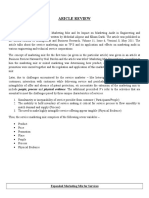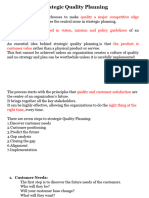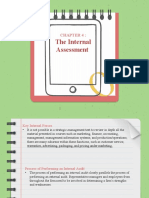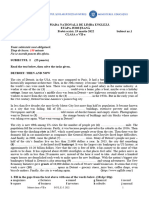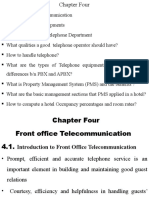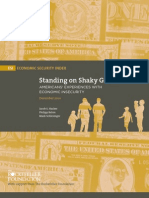Services Marketing Unit Iii
Services Marketing Unit Iii
Uploaded by
vikramadk1404Copyright:
Available Formats
Services Marketing Unit Iii
Services Marketing Unit Iii
Uploaded by
vikramadk1404Original Title
Copyright
Available Formats
Share this document
Did you find this document useful?
Is this content inappropriate?
Copyright:
Available Formats
Services Marketing Unit Iii
Services Marketing Unit Iii
Uploaded by
vikramadk1404Copyright:
Available Formats
Services Marketing UNIT III
UNIT-III
Understanding customer expectation through market research
• Key reasons for GAP 1,
• Using marketing research to understand customer expectation,
• Types of service research,
• Building customer relationship through retention strategies
• Relationship marketing,
• Evaluation of customer relationships,
• Benefits of customer relationship,
• levels of retention strategies,
• Market segmentation
• Basis & targeting in services.
Provider Gap 1
Department of Management Studies, JNNCE, Shimoga Page 38
Services Marketing UNIT III
Using marketing research to understand customer expectation,
(In this module the students can study following Information)
• Research objectives for services
• Criteria for an effective services research program
• Includes Qualitative and Quantitative Research
• Includes both perceptions and expectations of customers
Department of Management Studies, JNNCE, Shimoga Page 39
Services Marketing UNIT III
• Balances the cost of the research and the value of the information
• Includes statistical validity when necessary
• Measures priorities or importance
• Occurs with appropriate frequency
• Includes measures of loyalty or behavioural intentions
Research objectives for Services
Department of Management Studies, JNNCE, Shimoga Page 40
Services Marketing UNIT III
Stages in the Research Process
Stages in the (Marketing) Research Process
Criteria for an effective Services research Program
Department of Management Studies, JNNCE, Shimoga Page 41
Services Marketing UNIT III
Services research Program
Defined as the “composite of separate research studies & types needed to address Research
objectives & execute an over all measurement strategy”
1. Includes qualitative & Quantitative research
Qualitative are exploratory & preliminary research to conduct or to clarify problem
definition & prepare for more formal empirical research .
Quantitative research are the research which describe the nature, attitude, or behaviors of
customers empirically & to test specific hypotheses that a service Marketer wants to
examine.
2. Includes both perceptions & expectations of Customers
Quantitatively assess the levels of customer expectations & compare these with perception
levels usually by calculating the gap between expectations & Perceptions.
Department of Management Studies, JNNCE, Shimoga Page 42
Services Marketing UNIT III
3. Balances the cost of research & the value of the information
It is an assessment of the cost of research compared with its benefits or value for the
company.Time cost are also a factor including the length of time between the start of
research study & the time the data are available for use by employees.
4. Includes statistical validity when necessary.
Objective is to allow contact people to identify specific action items that will gain the
maximum return in customer satisfaction for individual customers.
5. Measures priorities or importance
Research must document the priorities of the customers. Prioritization can be Accomplished
in multiple ways.
Direct importance measures – Rank-order service Dimensions or attributes, rate on a
scale from “not at all important”/”Extremely important”.
Indirect importance - using the statistical procedures of correlation & regression
analysis which show the relative contribution of questionnaire items or requirements to over
all service quality.
6.Occurs with appropriate frequency
Customer expectations & perceptions are dynamic, companies need to institute a
service quality research process.for full understanding of market places acceptance of a
company’s service , marketing research must be on going “on going research” mean in
terms of frequency.
7. Includes measures of loyalty or behavioral intentions
Measuring positive & negative consequences of service quality along with over all
Satisfaction or service quality scores.
Ex: Behavioral intentions related to medical care include following instructions from doctor
taking medications & returning for follow up.
Types of research
• Customer Complaint Solicitation – involves in rigorous recording of numbers & &
types of complaints through many channels & then working to eliminate the requent
complaints.
• Critical incident studies – Its an effective alternative to complaint solicitation
involves in identifying the desirable & un desirable employee behaviors in service
encounters.
Department of Management Studies, JNNCE, Shimoga Page 43
Services Marketing UNIT III
can be communicated to contact personnel quite clearly in terms of what behaviors
satisfy customer.
• Requirement research – identifying the benefits & attributes that customers expect
in a service.
• Ex: Structured Brain storming/examine existing research about customer customer
requirement in similar industry. The 5 dimensions of quality service are generalizes
across industries.
• “Relationship” Surveys & SERVQUAL Surveys – poses questions about
elements in the customers relationship with the company(including service,product &
Price)
SERVQUAL Surveys involves a survey containing 21 service attributes grouped in to
5 service quality dimensions. By asking 2 different ratings on each Attribute like level of
service they would expect from excellent companies in a sector& the other reflecting the
perception of the service delivered by a specific company.
With that sector.it is used to gauge the overall relationship with the customer.
Usefulness of SERVQUAL in the areas
1. To determine the average gap score (customer perceptions & Expectations.
2. To assess a company’s service quality along each of the 5 SERVQUAL dimension.
3. To track customer expectations & -perceptions on individual service attributes &/ on
the SERQUAL dimensions –over time.
4. To compare a company’s SERVQUAL scores against those of compotators.
5. To identify & examine customer segments that differ significantly in their
assessments of a company’s performance.
6. To assess internal service quality- quality of service rendered by one department or
division of a company to others with in the same company.
Trailer Calls/post transaction surveys – The purpose of transaction surveys is to capture
about one or all of the key service encounters with the customer.
in this method customer are asked a short list of questions immediately after a
particular transaction about their satisfaction with the transaction & contact personnel with
whom they interact.
Department of Management Studies, JNNCE, Shimoga Page 44
Services Marketing UNIT III
Service expectation meeting & reviews – a form of customer research that is highly
effective involves eliciting the expectations of the clients at a specified time of the year &
then following up later ( usually after a year) to determine whether the expectations are
fulfilled.
Process checkpoint evaluations- process for delivering the services & then Structures the
feed back around the process, checking in at frequent points to ensure that the clients
expectations are being met.
Market-oriented ethnography – This approaches allows researcher to observe consumption
behavior in natural settings among the techniques used are , observation,interviews,
documents & examination of material possessions such as artifacts
Mystery Shopping - It is a unique form of research where companies hire outside research
organizations to send people in to service establishments & experience the service as if they
were customer. These Mystery shoppers are trained in the criteria important to customers of
the establishment
Customer Panels – panels are an ongoing groups of customers assembled to
Provide attitudes & perceptions about a service overtime. They offer a company regular &
timely customer information.
Lost customer research – This type of research involves deliberately seeking
customers who have dropped the companies service to inquire about their reasons for
leaving. It is similar to “ Exit interviews” with employees (in that asking open ended
questions to expose the reasons for defection & the particular events that led to
dissatisfaction.
Future Expectations Research – Customer expectations are dynamic & can change very
rapidly in markets that are highly competitive & volatile.
With the increase in competition as taste changes & as consumers become more
knowledge. Companies must continue to update their information & strategies. Like –
Department of Management Studies, JNNCE, Shimoga Page 45
Services Marketing UNIT III
Features research,lead user research,& Synectics approach
Department of Management Studies, JNNCE, Shimoga Page 46
Services Marketing UNIT III
Analyzing & interpreting Marketing Research Findings
One of the biggest challenging task in marketing research to convert a
complex data to a form that can be read & understood quickly by executives,
Managers & other employees who will make decisions from the research.
The Goal in this stage of the MR process is to communicate information Clearly to
the right people in a timely fashion.
1. Who gets this information?
2. Why do thy need it?
3. How will they use it?
4. Does it mean the same thing across cultures?.
Depicting MR findings graphically is a powerful way to communicate
research information.
• Tracking of performance, Gap scores, & competition – A simple way of tracking
performance is shown in the fig 5.3. Expectations & perceptions are plotted & the
gap between them shows the service quality short fall. while any attributes/
dimension of service can be tracked.
It allows mangers to have a better grasp of service improvement priorities for their
firm by comparing the firms service strengths & weakness against those of key
Competition.
Department of Management Studies, JNNCE, Shimoga Page 47
Services Marketing UNIT III
Zones of Tolerance Charts -
When companies collect data on the dual expectation levels – Desired Service & adequate
Services – along with performance data, they can convey the information concisely on zones
of tolerance .
Perceptions of company performance are indicated by the circle & the zone of
tolerance box, are bounded on the top by the desired service score & on the bottom by
adequate service.
When the perception scores are with in the boxes, the company is delivering service
that is above customers minimum level of expectation. When the perception scores are
below the boxes the company service performance is lower than the minimum level &
customers are dissatisfied with the company.
Department of Management Studies, JNNCE, Shimoga Page 48
Services Marketing UNIT III
Service Quality Perceptions Relative to Zones of Tolerance (by Dimensions)
Building Customer Relationships through retention strategy
• Relationship Marketing
• Relationship Value of Customers
• Foundations for Relationship Strategies
• The Customer Isn’t Always Right
• Customer Profitability Segments
• Levels of Relationship Strategies
Relationship Marketing
Relationship marketing - its goals, and the benefits of long-term relationships for
firms and customers
• Relationship Marketing is a philosophy of doing business that focuses on
keeping current customers and improving relationships with them does not
necessarily emphasize acquiring new customers is usually cheaper (for the firm)
Department of Management Studies, JNNCE, Shimoga Page 49
Services Marketing UNIT III
• keeping a current customer costs less than attracting a new one thus, the focus is
less on attraction, and more on retention and enhancement of customer
relationships
• Bucket Theory of Marketing – By L Schorr Has explained the
Relationship marketing as bucket theory.
The evolution of customer relationships
• Customer as strangers
• Customer as Acquaintances
• Customer as a friend
• Customer as partner
Customer Goals of Relationship
Department of Management Studies, JNNCE, Shimoga Page 50
Services Marketing UNIT III
Benefits to the Customer
• inherent benefits in getting good value
• economic, social, and continuity benefits
– contribution to sense of well-being and quality of life and other psychological
benefits
– avoidance of change
– simplified decision making
– social support and friendships
– special deals
Long term service relationships including Confidence benefits,Social benefits, &
special benefits.
Department of Management Studies, JNNCE, Shimoga Page 51
Services Marketing UNIT III
Benefit for firm
• Economic Benefits: willing to pay more
• Customer behavior benefit
• Human Resource management benefit
Benefits to the Organization of Customer Loyalty
• loyal customers tend to spend more with the organization over time
• on average costs of relationship maintenance are lower than new customer costs.
• employee retention is more likely with a stable customer base.
• lifetime value of a customer can be very high.
• Increased purchase overtime.
• Free Advertising through word-of-Mouth.
• Employee retention – (indirect benefit).
• Reduced marketing & administrative cost.
A Loyal Customer is One Who...
• Shows Behavioral Commitment
– buys from only one supplier, even though other options exist
– increasingly buys more and more from a particular supplier
– provides constructive feedback/suggestions
Department of Management Studies, JNNCE, Shimoga Page 52
Services Marketing UNIT III
• Exhibits Psychological Commitment
– wouldn’t consider terminating the relationship--psychological commitment
– has a positive attitude about the provider
– says good things about the provider.
Foundation for Relationship strategies.
• Quality offered in the core services – need to provide convincing support for the
argument that excellence in the core service/product Offered is essential to a
Successful relationship strategy.
• Market Segmentation & Targeting – Treat customers as individuals & develop
individual marketing plans for each customer.
• Continuous monitoring of relationship – basic market research in the form of annual
customer relationship surveys can be the foundation for such a monitoring strategy.
Steps in Market Segmentation and Targeting for Services
Department of Management Studies, JNNCE, Shimoga Page 53
Services Marketing UNIT III
Step 1: Identify Bases for Segmenting the Market - Segmenting the marketing by grouping
customers who share common characteristics (Design,delivery,promotion or pricing of the
service).
Step2:Develop Profiles of Resulting Segments – understanding how & whether the
segments differ from each other in terms of their profile (Demographic characteristics or
psychographics or usage segment.
Step3:Develop Measures of Segment Attractive-ness – the size & purchasing power of the
segments must be measurable to know the feasibility for investment & expansion.
Step4:Select the Target Segments – based on the size, growth potentiality, competitive
analysis, substitute services & relative power of buyers & suppliers market is selected.
Step5:Ensure that Segments Are Compatible – Services are performed in the presence of the
customer provider must be certain that the customers are compatible with each other.
Customer Isn’t Always Right
• Not all customers are good relationship customers:
– wrong segment
– not profitable in the long term
Department of Management Studies, JNNCE, Shimoga Page 54
Services Marketing UNIT III
– difficult customers.
The “80/20” Customer Pyramid
The Expanded Customer Pyramid
Department of Management Studies, JNNCE, Shimoga Page 55
Services Marketing UNIT III
Strategies for Building Relationships
• Foundations:
– Excellent Quality/Value
– Careful Segmentation
• Bonding Strategies:
– Financial Bonds
– Social & Psychological Bonds
– Structural Bonds
– Customization Bonds
Department of Management Studies, JNNCE, Shimoga Page 56
Services Marketing UNIT III
Levels of Retention Strategies
Portfolio of Services Research: Research Is NOT Just Surveys!
• Customer Complaint Solicitation
• “Relationship” Surveys
• Post-Transaction Surveys
Department of Management Studies, JNNCE, Shimoga Page 57
Services Marketing UNIT III
• Customer Focus Groups
• “Mystery Shopping” of Service Providers
• Employee Surveys
• Lost Customer Research
• Critical Service Encounters Research
Common means for answering questions
• Ask customers directly
– mail, phone, face-to-face, online
– one-on-one, in groups, formal/informal
• Observing customers
– anthropological tools, qualitative depth
• Get information from employees and front line service providers
• Database marketing research
– use customer information files
– “capture” behavior through data analysis
Department of Management Studies, JNNCE, Shimoga Page 58
You might also like
- Kataria Final ProjectDocument68 pagesKataria Final ProjectAastha MistryNo ratings yet
- A Study On Service Quality and Customer Satisfaction by Using The SERVQUAL ModelDocument51 pagesA Study On Service Quality and Customer Satisfaction by Using The SERVQUAL ModelVidhya ShNo ratings yet
- Listening To Customers Through ResearchDocument17 pagesListening To Customers Through Researchsweet_sagi16100% (2)
- Chapter 6Document4 pagesChapter 6Private JzNo ratings yet
- Program: MBA, Trimester 3, First Year Subject Code-305 MM: Customer Oriented Marketing of Services Unit No. 3Document23 pagesProgram: MBA, Trimester 3, First Year Subject Code-305 MM: Customer Oriented Marketing of Services Unit No. 3pavan kalyanNo ratings yet
- 2.1 Using Marketing Research To Understand Customer Expectation1Document23 pages2.1 Using Marketing Research To Understand Customer Expectation1Gopi Chand RaoNo ratings yet
- 05 (MS-1) - Market Analysis & Marketing Research For ServicesDocument15 pages05 (MS-1) - Market Analysis & Marketing Research For ServicesShoaib HasanNo ratings yet
- Elements in An Effective Marketing Research ProgramDocument12 pagesElements in An Effective Marketing Research ProgramHaNu reddy100% (3)
- Chap 005Document37 pagesChap 005levuagNo ratings yet
- Listening To Customer THR Research 17 JulDocument65 pagesListening To Customer THR Research 17 JulKazi Rabbi Al AzizNo ratings yet
- UNIT-4 Listening To The Custome - Researching For CustomerDocument2 pagesUNIT-4 Listening To The Custome - Researching For CustomerSwami Yog BirendraNo ratings yet
- Metoda PeneletianDocument8 pagesMetoda Peneletianodie99No ratings yet
- Listening To Customers Through ResearchDocument5 pagesListening To Customers Through ResearchRICARDO JIMENEZNo ratings yet
- NTRODUCTION To PROJECT REPORT Customer Satisfaction Is Related To The Human Activity Directed at Satisfying Human Wants Through The Exchange of Goods and ServiceDocument4 pagesNTRODUCTION To PROJECT REPORT Customer Satisfaction Is Related To The Human Activity Directed at Satisfying Human Wants Through The Exchange of Goods and ServiceeswariNo ratings yet
- Mcgraw-Hill © 2000 The Mcgraw-Hill CompaniesDocument11 pagesMcgraw-Hill © 2000 The Mcgraw-Hill CompaniesSudeep BartaulaNo ratings yet
- Marketing Services - Chap006Document28 pagesMarketing Services - Chap006FazleRabbiNo ratings yet
- Listening To Customer Through ResearchDocument12 pagesListening To Customer Through ResearchVishal JaiswalNo ratings yet
- Application of Marketing ResearchDocument11 pagesApplication of Marketing Researchhvijay885No ratings yet
- AssignimentDocument4 pagesAssignimentDerejaw MelkamuNo ratings yet
- Synopsis Customer Relationship Management Icici BankDocument8 pagesSynopsis Customer Relationship Management Icici BankLotus SaidiNo ratings yet
- A Study On The Customer Satisfaction of TheDocument44 pagesA Study On The Customer Satisfaction of TheMessiNo ratings yet
- Aricle Review: Expanded Marketing Mix For ServicesDocument9 pagesAricle Review: Expanded Marketing Mix For ServicesChhavi SainiNo ratings yet
- Q8 IM05 FinalDocument35 pagesQ8 IM05 FinalJb MacarocoNo ratings yet
- Final Project-1Document52 pagesFinal Project-1spdmilmaaNo ratings yet
- PQM - T03Document3 pagesPQM - T03Harinie SutharsonNo ratings yet
- Measuring Customer Demand For The Marketing Research Firm: A Study On BangladeshDocument15 pagesMeasuring Customer Demand For The Marketing Research Firm: A Study On BangladeshMd.Hafizur RahamanNo ratings yet
- SM Unit 3 & 4Document14 pagesSM Unit 3 & 4MANSI SHARMANo ratings yet
- Chapter 7 of TU BBA 8th Semester Marketing ResearchDocument33 pagesChapter 7 of TU BBA 8th Semester Marketing ResearchGaurab PaudelNo ratings yet
- 01lokesh Final ProjectDocument90 pages01lokesh Final ProjectHafiz RehmanNo ratings yet
- Market ResearchDocument20 pagesMarket Researchhaideralijr31No ratings yet
- Monitoring and Controlling Service ProvisionDocument8 pagesMonitoring and Controlling Service Provisionneil.winter342No ratings yet
- Customer Satisfaction - DeepikaDocument21 pagesCustomer Satisfaction - DeepikaMohmmed KhayyumNo ratings yet
- CustomerSatisfaction On SAFEZONE SECURE SOLUTIONS PRIVATE LIMITEDDocument25 pagesCustomerSatisfaction On SAFEZONE SECURE SOLUTIONS PRIVATE LIMITEDVijay ArapathNo ratings yet
- 6 Customer Satisfaction Asian PaintsDocument45 pages6 Customer Satisfaction Asian PaintsrajNo ratings yet
- Cbme Reviewer MidtermDocument35 pagesCbme Reviewer Midtermangelafernandez0309No ratings yet
- 04 (MS-1) - Marketing Mix in Marketing & ServicesDocument16 pages04 (MS-1) - Marketing Mix in Marketing & ServicesShoaib HasanNo ratings yet
- Strategic Planning-ExerciseDocument12 pagesStrategic Planning-ExerciseJumadi SuburNo ratings yet
- QC PlanningDocument34 pagesQC PlanningVasant bhoknalNo ratings yet
- Needed InfoDocument14 pagesNeeded InfoCuriosity At Its FinestNo ratings yet
- Chapter - 5: Listening To CustomersDocument9 pagesChapter - 5: Listening To CustomersanashussainNo ratings yet
- Assignments-Mba Sem-Iii: Subject Code: QM0001Document14 pagesAssignments-Mba Sem-Iii: Subject Code: QM0001Mithesh KumarNo ratings yet
- Principles and Practice of Services Marketing AS2Document12 pagesPrinciples and Practice of Services Marketing AS2Thandapani PalaniNo ratings yet
- Case 12Document15 pagesCase 12Deepak RamananNo ratings yet
- Understanding Customer NeedDocument9 pagesUnderstanding Customer Needrichanangia16No ratings yet
- Unit 9 - Customer SatisfactionDocument7 pagesUnit 9 - Customer SatisfactionMark Bacuel100% (1)
- Mahindra BoleroDocument74 pagesMahindra BoleroAnup Kanna60% (5)
- Unit 2Document142 pagesUnit 2Jatinder KaurNo ratings yet
- 2Document10 pages2रुस्मा थापाNo ratings yet
- Topic 4Document3 pagesTopic 4Topped Off Coffee ShopNo ratings yet
- Customer Satisfaction On Eureka ForbesDocument102 pagesCustomer Satisfaction On Eureka ForbesAjay Rajpoot83% (6)
- Customer Analysis & Insight: An Introductory Guide To Understanding Your AudienceFrom EverandCustomer Analysis & Insight: An Introductory Guide To Understanding Your AudienceNo ratings yet
- Market Research for Micro, Small and Medium Sized EnterprisesFrom EverandMarket Research for Micro, Small and Medium Sized EnterprisesNo ratings yet
- Benchmarking for Businesses: Measure and improve your company's performanceFrom EverandBenchmarking for Businesses: Measure and improve your company's performanceNo ratings yet
- Healthcare Staffing Candidate Screening and Interviewing HandbookFrom EverandHealthcare Staffing Candidate Screening and Interviewing HandbookNo ratings yet
- QcbsDocument61 pagesQcbstokal.vyenky123No ratings yet
- Subiect VII Varianta1Document3 pagesSubiect VII Varianta1Mirona GligaNo ratings yet
- Press Release For Tea Briefing Paper in English VersionDocument1 pagePress Release For Tea Briefing Paper in English VersionLet's Save MyanmarNo ratings yet
- Ch1 Projects in Contemporary OrganizationsDocument31 pagesCh1 Projects in Contemporary OrganizationsLê Bá Thành PhúNo ratings yet
- Roleplay Practice LVMDocument3 pagesRoleplay Practice LVME RNo ratings yet
- ERP SystemDocument18 pagesERP SystemWateen PythonNo ratings yet
- Project Mahindra TractorDocument5 pagesProject Mahindra TractorEzhumalai.SNo ratings yet
- Front OfficeDocument86 pagesFront OfficeAfera G MedhinNo ratings yet
- 13 Downstream Petroleum Economics Investment Analysis and Decision MakingDocument21 pages13 Downstream Petroleum Economics Investment Analysis and Decision MakingSwahil TrigaNo ratings yet
- Golden Rules of AccountingDocument5 pagesGolden Rules of AccountingVinay ChintamaneniNo ratings yet
- Year End Questionnaire 2019 - ISPDocument15 pagesYear End Questionnaire 2019 - ISPNom ZephaniahNo ratings yet
- Defaults and DonationsDocument43 pagesDefaults and DonationsPetronela NistorNo ratings yet
- Bain Southeast Asia Green Economy 2024 ReportDocument171 pagesBain Southeast Asia Green Economy 2024 ReportSanchita GuptaNo ratings yet
- Product Bulletin Orifice Fittings Design Enhancements To 6 Senior Orifice Fitting Ansi 150 To 600 Daniel en 55788Document1 pageProduct Bulletin Orifice Fittings Design Enhancements To 6 Senior Orifice Fitting Ansi 150 To 600 Daniel en 55788Marco GonzalezNo ratings yet
- Archive Copy: Booking AmendmentDocument2 pagesArchive Copy: Booking AmendmentNeiver PalaciosNo ratings yet
- Supply Chain and Logistics Management: The Future of Same-Day Delivery: Same As The Past?Document12 pagesSupply Chain and Logistics Management: The Future of Same-Day Delivery: Same As The Past?Anindya BasuNo ratings yet
- Resolv 9.2 HANA - WMS Users GuideDocument320 pagesResolv 9.2 HANA - WMS Users GuideVenkata RamanaNo ratings yet
- Standing On Shaky Ground - Effects of Longterm Economic in SecurityDocument36 pagesStanding On Shaky Ground - Effects of Longterm Economic in SecurityJill Allison WarrenNo ratings yet
- Concept of Development AdministrationDocument9 pagesConcept of Development AdministrationBeverly A. CannuNo ratings yet
- ReceivablesDocument5 pagesReceivablesHanns Lexter PadillaNo ratings yet
- Certificate 3Document1 pageCertificate 3ganiyevadurdona28No ratings yet
- An Overview On Sap SDDocument52 pagesAn Overview On Sap SDchonchalNo ratings yet
- 10 1016@j JDMM 2016 06 011 PDFDocument10 pages10 1016@j JDMM 2016 06 011 PDFLuisa Fernanda Hincapie VelezNo ratings yet
- SCMHRD: MBA-BA, Batch of 2020-22 Financial Accounting (Semester 1) - AssignmentDocument10 pagesSCMHRD: MBA-BA, Batch of 2020-22 Financial Accounting (Semester 1) - AssignmentSiddhant SinghNo ratings yet
- March 2020 ABJDocument64 pagesMarch 2020 ABJMichelle LimNo ratings yet
- 424 PDFDocument24 pages424 PDFSakshi JagdaleNo ratings yet
- (March 1th 2021) Proforma Invoice For Horizontal Screen and Rotary FeederDocument1 page(March 1th 2021) Proforma Invoice For Horizontal Screen and Rotary Feederreka ZNo ratings yet
- FOCUS - Indofood Sukses Makmur: Saved by The GreenDocument10 pagesFOCUS - Indofood Sukses Makmur: Saved by The GreenriskaNo ratings yet
- Bar Q & A Related To Credit Transactions: (Question, 1993)Document16 pagesBar Q & A Related To Credit Transactions: (Question, 1993)FELIPE, JEMARD M.No ratings yet





















